
 |
Solar Questions |
Post Reply 
|
Page <1234> |
| Author | |
offgrid 
Senior Member 
Joined: 23 Jul 2018 Online Status: Offline Posts: 5290 |
 Post Options Post Options
 Quote Quote  Reply Reply
 Topic: Solar Questions Topic: Solar QuestionsPosted: 12 Dec 2020 at 10:06am |
|
I was talking about the battery to positive conductor for the solar wiring, at the battery end. There is already a 40A fuse on the battery to house wiring, located at the panel. It would be better to have that fuse located at the battery as well because otherwise that conductor isn't protected, but FR in their infinite wisdom chose not to do that.
Basically the rule of thumb for any circuit protection, regardless of voltage, is that each and every piece of wire should be protected from excess current flowing into it from any potential source. So for the solar circuit you have two sources, the battery and the solar module/controller. Say you accidentally short a cable run to a portable solar kit from the battery. The current flow which is normally from the solar to the battery will reverse and flow from the battery into the short. That's why the fuse or breaker needs to be at the battery. Current will flow into the short from the solar end also, but solar modules are by nature current limited, so if you short one out the current only goes up by about 10%, no big deal. The wire is automatically protected without needing a fuse at the solar end. OTOH, shorting the battery will produce heaps of current which without a fuse or breaker will promptly melt the insulation off the cable and start a fire. Hope that makes sense.
|
|
|
1994 Chinook Concourse
1995 RV6A Experimental Aircraft 2015 Rpod 179 - sold |
|
 |
|
Dirt Sifter 
Senior Member 
Joined: 30 Dec 2018 Location: Right side OR Online Status: Offline Posts: 170 |
 Post Options Post Options
 Quote Quote  Reply Reply
 Posted: 12 Dec 2020 at 10:16am Posted: 12 Dec 2020 at 10:16am |
|
Thank you! Got it. Much clearer now. Will check my factory set up next time I get to the hay shed.
|
|
|
Greg n Deb 2020 195 HRE
'07 Tundra 5.7L., '17 Tacoma 3.5L. Both with tow packages 1 Puggle, 1 Chihuahua support staff |
|
 |
|
Pod People 
Senior Member 
Joined: 22 Sep 2011 Location: Chapel Hill,NC Online Status: Offline Posts: 1067 |
 Post Options Post Options
 Quote Quote  Reply Reply
 Posted: 12 Dec 2020 at 10:41am Posted: 12 Dec 2020 at 10:41am |
|
there has been no mention of the solar charge controller in this discussion. Just to make sure I understand correctly, the solar panel feeds the solar charge controller and then on to the battery. I have a fuse between the solar charger controller and the battery. Is that correct? thank you Vann
|
|
 |
|
offgrid 
Senior Member 
Joined: 23 Jul 2018 Online Status: Offline Posts: 5290 |
 Post Options Post Options
 Quote Quote  Reply Reply
 Posted: 12 Dec 2020 at 10:59am Posted: 12 Dec 2020 at 10:59am |
Correct. Locate the fuse at the battery end of the positive output wire from the charge controller. The fuse is there to protect the wire, so it should be no higher than 20A for 12 gauge, 30A for 10 gauge, or 40A for 8 gauge. Could be a smaller fuse/breaker if you want, but per Code needs to be a minimum of 1.56 x Isc (short circuit current rating listed on the solar module label). The 1.56 multiplier - edit: two 25% factors multiplied together (1.25 X 1.25 = 1.56) is to avoid nuisance tripping if you get extra output from what's called the "edge of cloud" effect, where extra sunshine reflects off nice white clouds onto the solar module.
|
|
|
1994 Chinook Concourse
1995 RV6A Experimental Aircraft 2015 Rpod 179 - sold |
|
 |
|
yelvington 
Newbie 
Joined: 05 Nov 2020 Location: GA Online Status: Offline Posts: 18 |
 Post Options Post Options
 Quote Quote  Reply Reply
 Posted: 15 Dec 2020 at 8:30am Posted: 15 Dec 2020 at 8:30am |
|
I read Offgrid's comment to mean a fuse between the solar panel and the battery. (Is there any reason this can't be done at the solar panel end?)
The battery's wiring already connects to a circuit breaker in the power distribution box. |
|
 |
|
Dirt Sifter 
Senior Member 
Joined: 30 Dec 2018 Location: Right side OR Online Status: Offline Posts: 170 |
 Post Options Post Options
 Quote Quote  Reply Reply
 Posted: 15 Dec 2020 at 8:38am Posted: 15 Dec 2020 at 8:38am |
|
|
|
Greg n Deb 2020 195 HRE
'07 Tundra 5.7L., '17 Tacoma 3.5L. Both with tow packages 1 Puggle, 1 Chihuahua support staff |
|
 |
|
offgrid 
Senior Member 
Joined: 23 Jul 2018 Online Status: Offline Posts: 5290 |
 Post Options Post Options
 Quote Quote  Reply Reply
 Posted: 15 Dec 2020 at 9:17am Posted: 15 Dec 2020 at 9:17am |
|
If you connect the solar system at the battery then the fuse in the panel doesn’t protect the wires. If you were to get a short on those wires hundreds of amps would flow from the battery into the short and cook off the wires.
You don’t need a fuse on the solar side of the controller at all because if those wires get shorted nothing happens except that you stop charging. Unlike a battery, the solar module short circuit current (called Isc and should be listed on the module label) is current limited by the amount of sunshine on the module to only about 10% more than the normal max power current (Imp) so the fuse wouldn’t blow anyway. Try it sometime. With the module disconnected from the controller short its two output leads together. All you’ll get is a little spark when you make or break the connection, the wires and the solar module will be fine. Just don’t try that with the battery leads unless you like electrical fires or exploding batteries. Only if you had 3 or more solar modules wired in parallel would you need fuses for them to keep current from 2 or more solar modules from backfeeding into the shorted one. Edit: the other question was placement fuses. If you think of an electrical system like a plumbing system it becomes clear. If you get a leak in a pipe and your only cutoff valve is downstream from where the leak is it does you no good. That's why fuses and circuit breakers are always placed upstream from the wires or devices they are supposed to protect. So a battery fuse or circuit breaker that is 20 ft from the battery doesn't help if you get a short in the wire in between.
|
|
|
1994 Chinook Concourse
1995 RV6A Experimental Aircraft 2015 Rpod 179 - sold |
|
 |
|
Ricktoon 
Groupie 
Joined: 24 Sep 2020 Location: Montana Online Status: Offline Posts: 67 |
 Post Options Post Options
 Quote Quote  Reply Reply
 Posted: 03 Mar 2021 at 11:50am Posted: 03 Mar 2021 at 11:50am |
|
I put together my portable solar panel setup this week. Purchased 2 HQST 100 W Monocrystalline Solar Panels from Amazon along with a Renogy 20A waterproof charge controller. I also bought 20 feet of 10AWG wire with the correct connectors and the male and female SAE connectors. I assembled the panels into one unit with legs made from spare aluminum banisters from my friend's railing project. The unit folds up and the wire and charge controller can fit inside. I also bought a case big enough to store the unit when closed. Additional materials include: hinges, clasps to close the case, nuts and bolts, etc. The wire runs from the solar panels to the charge controller with a 15Amp in-line fuse. From the charge controller I attached the male SAE connector and the female will install on the battery case and connect to the battery with a 20A fuse on the positive lead. I can then just plug and unplug the unit at the batteries and attach the charge controller to the frame with magnets when in use. 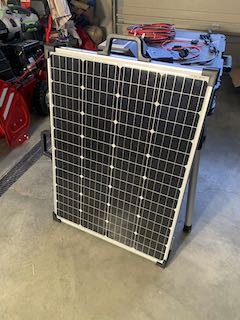 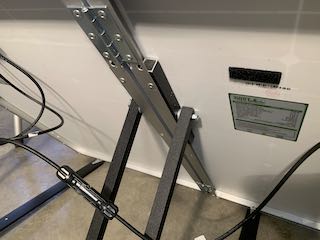 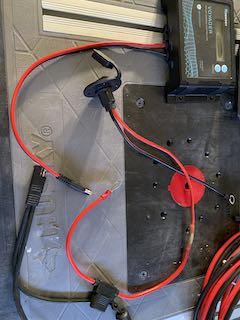 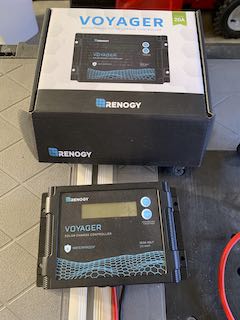 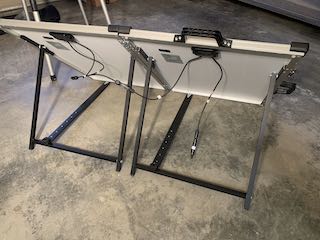 |
|
|
Rick and Ellen B
2019 Chevy Colorado 2021 Rpod 196 |
|
 |
|
offgrid 
Senior Member 
Joined: 23 Jul 2018 Online Status: Offline Posts: 5290 |
 Post Options Post Options
 Quote Quote  Reply Reply
 Posted: 03 Mar 2021 at 1:31pm Posted: 03 Mar 2021 at 1:31pm |
|
Looks nice! Should work out well, and you can always increase the length of the wires to the battery if you find you need more length to get the solar panel into the sun.
I assume you mean the rPod frame when you say you are attaching the controller to the frame with magnets? Nothing else is made of steel I don’t Think. Did you glue the magnets to the controller? Also, it won’t hurt anything that you have made the 15A fuse there but for future reference for others its not really needed. Solar modules are current limited and won’t produce enough current to blow the fuse anyway, unless you have 3 or more in parallel. You do need the fuse at the battery because it can produce hundreds of amps. |
|
|
1994 Chinook Concourse
1995 RV6A Experimental Aircraft 2015 Rpod 179 - sold |
|
 |
|
Ricktoon 
Groupie 
Joined: 24 Sep 2020 Location: Montana Online Status: Offline Posts: 67 |
 Post Options Post Options
 Quote Quote  Reply Reply
 Posted: 03 Mar 2021 at 5:53pm Posted: 03 Mar 2021 at 5:53pm |
|
I will attach magnets to the controller so I can attach to frame. May also come up with place near batteries if needed. Even though the charge controller is waterproof, I am looking at a small pelican type box to help protect it. The 15A fuse between the panels and controller is just an extra precaution on my part.
|
|
|
Rick and Ellen B
2019 Chevy Colorado 2021 Rpod 196 |
|
 |
|
Post Reply 
|
Page <1234> |
| Forum Jump | Forum Permissions  You cannot post new topics in this forum You cannot reply to topics in this forum You cannot delete your posts in this forum You cannot edit your posts in this forum You cannot create polls in this forum You cannot vote in polls in this forum |